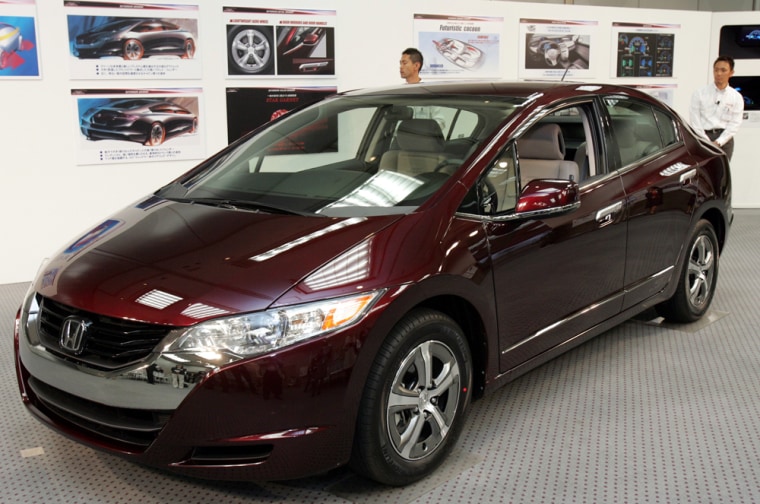With great fanfare, Honda’s first-ever zero-emission, hydrogen-powered car rolled off the automaker’s production line earlier this month. But don’t look for one on a highway near you anytime soon.
The FCX Clarity, which runs on hydrogen and electricity and emits only water as a byproduct, will be available for lease starting July to a very, very limited number of customers in California. Among the first drivers — hand-chosen by the automaker — are movie star Jamie Lee Curtis and filmmaker Ron Yerxa.
Honda’s Clarity may sound like a breakthrough for drivers struggling with the high price of gasoline, but it’s just one of a wide range of potential solutions being tested to wean the auto economy off costly, polluting crude oil. The prospects of hydrogen as a solution are far from certain, observers say, as it could take several decades until hydrogen-powered cars are widely available.
“If you were to take a poll of automotive journalists I think about half of them would say the future is hydrogen,” said Tom Appel, associate publisher of Consumer Guide Automotive, which offers buying advice to car consumers. “It’s clean, and it looks like it will be available at a low cost at some point in the future. So it looks like it should work when the infrastructure is put in place, but that’s going to be some time from now.”
So far, Honda's plans are modest. The Japanese automaker intends to export just 200 Claritys to the U.S. over the next three years, with selected customers offered a subsidized, $600-a-month, three-year lease, which includes maintenance and insurance. With the small volume the vehicles cost several hundred thousand dollars each to manufacture.
The vehicle certainly looks promising on paper. Honda says the vehicle is twice as energy-efficient as a gas-electric hybrid, such as a Toyota Prius, and three times that of a regular gas-powered car.
Honda has designed the car to be as driver-friendly as possible. The vehicle does zero to 60 mph in 10 seconds, has a top speed of 100 mph and runs for 280 miles on a single tank of compressed hydrogen gas — all acceptable specifications for a regular car, notes Appel. But a number of obstacles remain before hydrogen cars can be considered a viable alternative.
“The main issue here is inconvenience; there are only a few hydrogen filling stations dotted around the country, and there’s the battle to make this a viable car to mass produce,” Appel said. “And at $600 a month for a lease, the Clarity is still fairly pricey even though it’s subsidized, and the cost of producing fuel cells is still very expensive.”
Hydrogen-powered cars like the Clarity run on power generated by mixing oxygen with hydrogen in a fuel-cell stack, where the elements react in the presence of an electrolyte. Fuel cells are heavy and difficult to make, fragile and not completely reliable in freezing temperatures, according to Appel.
Other hydrogen-fueled cars are now undergoing controlled testing on U.S. roads, including Chevrolet’s midsized Equinox sport utility vehicle and the federal and state governments are working to jump-star a hydrogen fuel infrastructure. California, Florida and a number of European nations are working on building “hydrogen highways” that would allow such vehicles to travel and refuel.
These highways are not yet established, and at present there are only 15 hydrogen fuel stations that the Department of Energy has set up with private partners in California, Florida, New York, Washington, D.C., and Michigan. By comparison, the National Petroleum News says there are currently around 164,000 regular gas stations in the United States.
The number of hydrogen stations is expected to grow, but very slowly. In California, for example, there are plans to add 24 more fueling stations by 2010 under the California Hydrogen Infrastructure Project — a joint venture of major automakers, the Energy Department and hydrogen producers.
In terms of fuel-efficiency, the Clarity potentially offers consumers some welcome relief at the pump. The first Clarity users will pay about $25 to fill the tank with its 280-mile range. The equivalent cost for even one of Honda’s most fuel-friendly vehicles, such as the Accord sedan, would be about $55 at current gas prices.
The question is will hydrogen ever become a dominant fuel source for cars. For all its appeal, the Clarity is still at least a decade from mass production, according to Honda.
“The cost of manufacturing the vehicle is still very far away from where it needs to be,” said Phil Reed, consumer advice editor at automobile information Web site Edmunds.com. “It costs $500,000 to make each one, and the hydrogen infrastructure is just not there, so why would anyone buy one?”
For drivers looking for a solution similar to the Clarity, Reed points to a more viable alternative that already exists in California — Honda’s Civic GX, which runs on natural gas, produces almost no emissions and is only slightly more expensive than a regular Civic. The GX gets around the infrastructure problem by offering a home refilling station called ‘Phill’ that taps into the gas line in your home. Drivers can fill up their fuel tanks at home and one full tank provides about 250 miles of travel.
“One of our editors here at Edmunds.com is using it and has calculated that he’s getting the equivalent cost of $2 per gallon. That’s looking good compared to $4.50 a gallon for gas, and you can get into the car pool lane here in California,” said Reed. “So for certain people this is an incredible commuter vehicle.”
